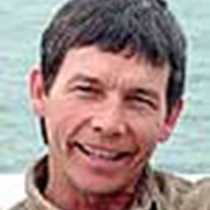Sand Peso(Dollar) Beach, Baja California, México
Morning was brisk. The fresh westerlies swept the tangerine-frosted dawn clouds away. Wave after wave of Brandt’s and double crested cormorants streamed northward into the protected waters of Hull Canal, Magdalena Bay. The magnificent frigate birds soared overhead. Our first morning in Baja was off to a refreshing start.
After breakfast most of us rode the Zodiacs to Isla Magdalena. This 60-mile long island has two small metamorphic mountain ranges, but is mostly made out of fine granitic sand, which we explored. Black-tailed jackrabbit, desert wood rat and coyotes as well as darkling beetles and lizards made lovely tracks on the ‘barchan’dunes. On the open Pacific side of the island, the surf pounded the sand and the wind revealed the dead sand dollars (which we nicknamed sandpeso!) high up on the desolate beach. This specimen must have sat on the ocean bottom for a while, as it was covered with barnacles before being flipped onto shore, perhaps by last year’s hurricane. We found many skulls from sea turtles and huge male sea lions to both species of dolphin common to Baja: the bottlenose and long-beaked common. As far as the binoculars could scan, we were the only people on the beach. The salty air, the thundering surf, and the sheer expanse were welcomed by all.
After Xim Xim, a Brazilian fish soup with scallops, and fresh baked bread we picked up our Mexican pilot and proceeded to head north up the narrow Hull Canal to Boca de Soledad 30 miles away. Mangroves fringed the towering dunes, great flights of cormorants and brown pelicans frantically chased hidden fish, perhaps sardines, a lone coyote tracked the shoreline and thousands of shorebirds, including nine species of heron and the same of sandpiper, dotted the mudflats. As we neared our anchoring spot a gray whale mom and calf surfaced near the ship and we got our first taste of a great day in Baja.
Morning was brisk. The fresh westerlies swept the tangerine-frosted dawn clouds away. Wave after wave of Brandt’s and double crested cormorants streamed northward into the protected waters of Hull Canal, Magdalena Bay. The magnificent frigate birds soared overhead. Our first morning in Baja was off to a refreshing start.
After breakfast most of us rode the Zodiacs to Isla Magdalena. This 60-mile long island has two small metamorphic mountain ranges, but is mostly made out of fine granitic sand, which we explored. Black-tailed jackrabbit, desert wood rat and coyotes as well as darkling beetles and lizards made lovely tracks on the ‘barchan’dunes. On the open Pacific side of the island, the surf pounded the sand and the wind revealed the dead sand dollars (which we nicknamed sandpeso!) high up on the desolate beach. This specimen must have sat on the ocean bottom for a while, as it was covered with barnacles before being flipped onto shore, perhaps by last year’s hurricane. We found many skulls from sea turtles and huge male sea lions to both species of dolphin common to Baja: the bottlenose and long-beaked common. As far as the binoculars could scan, we were the only people on the beach. The salty air, the thundering surf, and the sheer expanse were welcomed by all.
After Xim Xim, a Brazilian fish soup with scallops, and fresh baked bread we picked up our Mexican pilot and proceeded to head north up the narrow Hull Canal to Boca de Soledad 30 miles away. Mangroves fringed the towering dunes, great flights of cormorants and brown pelicans frantically chased hidden fish, perhaps sardines, a lone coyote tracked the shoreline and thousands of shorebirds, including nine species of heron and the same of sandpiper, dotted the mudflats. As we neared our anchoring spot a gray whale mom and calf surfaced near the ship and we got our first taste of a great day in Baja.




